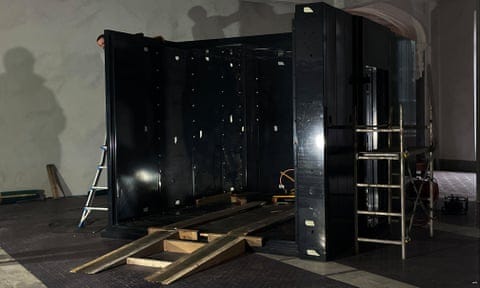Art and Life Thrust Into Existential Opposition
A dissident Russian artist holds an irreplaceable art collection under a chemical Sword of Damocles that will strike if Julian Assange dies in prison.
Artist Andrei Molodkin persuaded a coterie of collectors to give him control of works by Picasso, Rembrandt and Warhol, worth some $50 million, which he has imprisoned in a vault alongside powerful corrosive chemicals that, if released, will disintegrate everything inside. The reaction will be triggered if, in any 24 hour period, Julian Assange cannot be confirmed alive. It’s a scheme simultaneously worthy of Erwin Schrödinger, Abbie Hoffman and Dr. No.
Assange has been held in London’s Belmarsh prison for more than five years, and is fighting extradition to the United States to be charged against violating The Espionage Act, among other offenses. The founder of Wikileaks has not lived as a free person since 2012, when he received asylum in the Ecuador’s London Embassy, where he lived in isolation. It’s hard to imagine Assange walking free without political changes in the U.S., UK and Europe that seem, at best, unlikely. So, Molodkin isn’t demanding Assange’s freedom but his survival. Time will, of course, eventually render those propositions equal.
In the past, the Middlebrow has criticized activists for attacking art, disrupting performances or interfering with other people’s enjoyment of life. My major opposition is not that the causes that motivate the activists are wrong, but that to assume your cause is so important that you’re willing to violate somebody else’s communion with culture demands a special kind of arrogance.
There’s a lot to unpack here:
We can start with Assange and ask whether he is a worthy cause for activism. His use of the internet to expose secrets held by both public and private entities around the world has earned him love and hate from the left and right. That can’t be adjudicated here. But I do believe you can find his safety (if not his freedom) a worthy cause whether you consider him a journalist, activist, spy, criminal, dupe, or some soup made from what reads like Graham Greene’s grocery list. Let’s give Molodkin credit for picking a decent cause for activism.
Molodkin’s art is often political and if you’re inclined to believe he is some stooge of Vladimir Putin, check out the website of his “Foundry” which features an augmented reality, public exhibition called Putin Filled with Ukrainian Blood. It’s fair to grant that when Molodkin says he is acting from his beliefs, he means it.
But, Molodkin is an artist. So, is this performance art? In a sense it is, even if he denies it, and he has won attention with his performance. But this is not Banksy getting one up on the auction houses by selling a self-shredding painting. It reminds me a bit of Franz Kafka’s The Hunger Artist, where an artist wastes himself away as a public lament about art in an apathetic society. But that’s not quite what Molodkin is doing, either. I’ll take the artist at his word when he told The Guardian, “I’m not trying to destroy art, and I don’t believe I will have to.” Molodkin and his donor collaborators are making a threat to authorities in the United States and the United Kingdom. They are practicing politics and art together and that synthesis is one of the best reasons to practice a creative life.
Which brings us to the question of how effective this threat will be. I am sadly sure that the people running prosecutor’s offices, courts, prisons, jails and spy agencies value the work they are doing far more than they do a work by Picasso sitting in some private collection. I’m not saying that these individuals love art, only that they will not act to save it. They will not prioritize it.
I doubt Molodkin imagines some prosecutor will give up Assange to save a Picasso. The gambit here is more subtle — he is trying to raise a question to make the people imprisoning, prosecuting and judging Assange think about what they are doing and perhaps to ask new questions. The problem here is that what is a moral issue for Molodkin is a procedural issue for his opponents.
Then there’s the issue of the donated works, what they are worth and what it means that such unique records of human accomplishment can be sacrificed in a private arrangement. While this doesn’t undermine Molodkin’s project, it raises questions about who you have to be and who you have to know in order to own the assets necessary to make a scheme like this noteworthy. It raises questions about whose causes are heard and why.
Molodkin’s act will probably not affect the outcome of Assange’s criminal journey, but he knows that. It will make some people think, but not the right people. Molodkin knows that, too. There is a real possibility Assange will die in prison, with or without ever receiving a proper trial or the public ever really getting the chance to scrutinize the proceedings. What then?
I gather Molodkin will follow through.
But he should not.
If Assange dies in prison, Molodkin should betray his donors by placing their art in the power of some public trust, in a jurisdiction safe from international property law, where they can be preserved for public viewing in perpetuity.
Humanity’s right to the works that humanity creates is, after all, what Wikileaks and Assange are all about.


Great final paragraph that I didn’t see coming. I also like your solution. Very sensible to refrain from adjudicating that issues with Assange.